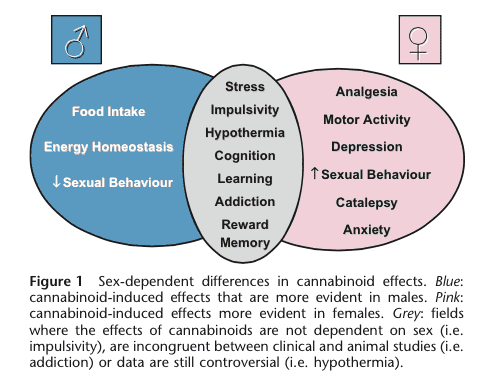One of the reasons we encourage cannabis patients to experiment with various strains for their ailment is because we have seen different strains work for different people. Perhaps you have a potent strain you like to medicate with that your friend feels no effect from at all. What makes one person paranoid could relax another simply because each person has different brain chemistry and body fat distribution. Taking this further, we might ask the question: “In general, is the experience of medicating with cannabis different for men than for women?” After all, men and women have different hormone profiles and different fat distribution patterns as well, right? This is exactly the question we hope to tackle today, although we’d like to remind readers that when we say “male” and “female, we are talking about at-birth medical identification of sex as opposed to “gender”, which obviously cannot be reduced down to stereotypes.
After digging through the relevant research we’ve seen a slight disagreement in animal vs. human studies. Animal studies show less of a sexual differentiation or one in which females have higher THC concentrations in the brain. Human studies mostly appear to be the opposite, with males and females exhibiting different sensitivities in various areas. A good deal of this could be social, but a large part has to do with gonadal hormones. As we discussed in the last article, estrogen is capable of regulating cannabinoid receptor density and signal transduction. How much estrogen you have in your body at a given time can affect how receptive you are to external cannabinoids and how powerful those interactions are. The estrogen cycle also fluctuates with the ovulation cycle in women, which therefore means that medication may have to be adjusted over the course of the month in response to body changes. We touched on this in a previous post, but just to re-state, the highest levels of endocannabinoids (the body’s natural cannabinoids) circulate the body during ovulation and are lower during the luteal phase. So far we haven’t observed cannabis intake to disrupt the reproductive system. More research needs to be done to get a grip on how cannabis in-take can affect fertility. However, cannabis should certainly be refrained from during pregnancy, as it has been shown to increase chances of miscarriage and neural damage within the child.
On the opposite side of the fence, while males have more static, unchanging levels of cannabinoid receptors and sensitivities, they are also more sensitive to body temperature changes and most importantly food-intake changes as a result of consuming cannabis. One study from the Western University of Health Sciences, implanted temperature sensors in mice and monitored feeding rates after administration of cannabinoids. These studies found that the males increased feeding much more than females and decreased body temperature by an extra half degree Celsius, which is a considerable drop for any warm blooded animal seeking to maintain a constant body temperature. The impetus for performing the study with rodents came from the observation that similar effects had been reported in humans. Reducing that down to a simple statement this indicates that yes, males are more likely to get the munchies and overeat while medicating with cannabis than females.
The chart below (from the CNR Neuroscience Institute) summarizes some of the main differences in effects of cannabinoids based on a review of recent research. Keep in mind that unless noted with an arrow, “stress” does not mean “increases stress”, just that the “stress” area of the brain is affected. For instance, in the case of “stress” specifically, cannabis intake is actually reported to reduce stress in both males and females, as we’ve written about before. One interesting note on the chart however, is the way in which male sexual behavior decreases, while female sexual behavior increases. We’d like to see more research before we discuss this component specifically, but this seems to match anecdotal reports about cannabis and may be the basis for emerging lines of cannabis-based sexual enhancement products.
In closing, we’d like to re-state to readers that these findings are in regard to at-birth medical specifications of male and female, as opposed to the more ambiguous construction of gender. Aside from intersex individuals (which cannot be biologically identified at birth), the possibility that one at-birth male could have a brain chemistry or hormonal system similar to another at-birth female is still possible, and these are not hard and fast rules. However, we can say with confidence that the experience of medicating with cannabis is different in both symptom and intensity for each group. We look forward to providing you with further information on the topic as more research arrives.
Works Cited
Liana Fattore and Walter Fratta. (2010) How important are sex differences in cannabinoid action? British Journal of Pharmacology (2010) 160:544-548.
Borzoo Farhang, Shanna Diaz, Stephanie Tang, et. al. (2009) Sex differences in the cannabinoid regulation of energy homeostasis. Psychoneuroendocrinology (2009) 34(0 1): S237-S246.


